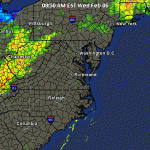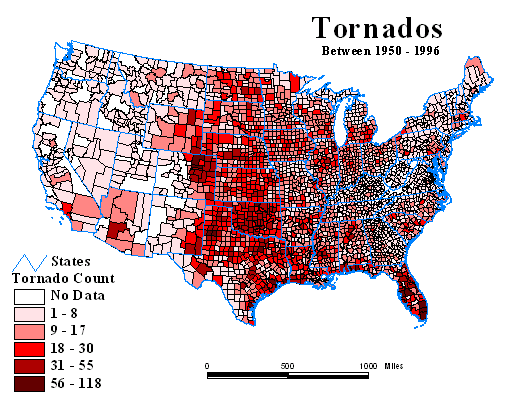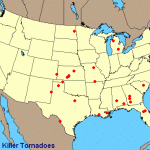 |
Archive for the ‘Tornadoes’ Category
Tuesday, May 13th, 2008
Many news reports have recently been written about the large number of tornadoes that have hit the United States this year, primarily, meteorologist say, due to the southern dip in the jet stream. Indeed, there is a possibility that this season could be one of the most active and deadliest. Here is a map from NOAA that documents the peak seasons for each state in the contiguous United States.

Posted in Tornadoes | No Comments »
Wednesday, April 30th, 2008
Beth Wescott was able to contact Jan Daum at the Sentara Obici hospital. Here is her report:
I spoke at length with Jan Daum of Sentara Obici in Suffolk, Virginia. Seems the tornado hopped over the hospital and demolished an adjoining strip mall and inflected heavy damage to their outpatient pediatrics center. Yes, there were windows broken and Jan stayed on the job until 9:30 pm. However, since it was wind, not water, doing the damage, her basement level library was unscathed. The cars in the hospital parking lot fared well, but those 200 yards away were twisted and broken. They saw lots of cuts and bruises and a broken arm or two, but escaped death and mayhem.
Posted in Tornadoes | No Comments »
Tuesday, April 29th, 2008
Six tornadoes have now been confirmed in eastern and southern Virginia yesterday. The Richmond Times Dispatch reported that Sentara Obici Hospital had received some damage, primarily broken windows. Beth Wescott, SE/A Network Access Coordinator, is attempting to reach the network member contact person at Obici.
Click here for video reports of tornado damage in the Suffolk area.
This is a good time to review the map below. If your area has a history of tornadoes, please make sure your tornado response procedures are up-to-date.

Posted in Tornadoes | No Comments »
Wednesday, February 6th, 2008

The weather is creating news today. A powerful low pressure front is pushing through towards the Northeast from the Mississippi Valley, hitting the warm temperatures we’ve had this week, and creating some fierce thunderstorms and spawning tornadoes in Tennessee and Kentucky this morning. We’ve sent a weather alert to our staff reminding everyone of what our procedures are for responding to a tornado warning or sighting in our area:
-
Tornado warning: announce the warning is in effect, ask staff and patrons to move away from windows and exterior doors
-
Tornado sighted in the area: announce we are initiating Shelter-In-Place, and that everyone should take shelter on our basement level in the hallway. (Best shelter from a tornado: as low in the building as possible, as close to the center of the building as possible)
In addition to monitoring the weather via computers, we have an All-Hazards radio that will issue an alarm in the event of an official alert. So far, we have not had to use it, but today it may come in handy.
We hope our colleagues to the west of us have fared well today. Stay in touch!
Posted in Alerting Systems, Current Incidents and Alerts, Hazardous Weather Outlook, Shelter in Place, Tornadoes, and Hazardous Weather Outlook | No Comments »
Saturday, January 26th, 2008
Winter is a good time to begin preparing for tornado season. Do you live and work in an area which has experienced tornadoes? If so, what’s your plan for alerting patrons that a tornado warning has been issued for your area? What are the safest places in your building? What’s your tornado safety plan for your home?
Unless you’ve been in a tornado, it’s hard to imagine its destructive powers. On May 13, 2000, my family and I sat in our Honda Civic at a local high school parking lot while an F1 tornado went over us. We had been out for ice cream and had no idea of the possibility of a tornado. In fact, we were parked in the parking lot because I wanted to get a good look at some spectacular storm cloud formations coming in from the southwest. After striking the high school, the tornado then took northeasterly track right over our house, resulting in several downed trees. An F1 tornado is quite low on the Fujita scale, however, the winds from the tornado, estimated at 80 to 100 mph, tore off roofing from the high school and sent metal barrels tumbling past our car. Did it sound like a train? Not this one. However, our car shook violently and visibility was reduced to almost nothing due to the intensity of the rain. Our girls, age 7 and 5 at the time, sat screaming in the back seat through the whole event, which probably lasted less than a minute. My wife and I, greatly concerned, kept assuring them that everything was going to be fine. Everything did turn out to be fine, and we all now have a much greater respect for tornadoes.
The map below is from data provided by the National Climatic Data Center.

Posted in Tornadoes | No Comments »
Tuesday, November 27th, 2007
For a list of 2007 tornadoes that resulted in fatalities, check out this site from NOAA. Some of the locations may surprise you. Also, check out these sobering aerial photographs of the aftermath of the tornado that struck Greensburg, Kansas, on May 4, 2007.

Posted in Tornadoes | No Comments »
Thursday, July 12th, 2007
Claudia LeSueur, from the Thompson Medical Library at the Sumter Regional Hospital in Americus, Georgia, talks about a tornado that affected the hospital library in March 2007.
| Interview date: |
July 12th, 2007 |
Questions:
(1.) What happened in your community (i.e., what was the disaster/emergency)?
(2.) How did the library respond? How did the librarian respond? Were there non-traditional (unusual) roles that the librarian performed?
| News about the tornado reached me about 10:30 pm. It took me one hour to drive two miles due to trees having fallen across the roads all around town. Much help was needed at the hospital and people really rallied. However, by the time I got there the patients had been moved to the OR and ER areas. Patients were being transferred to other hospitals and ambulatory patients were waiting in hallways near ER to be transported as well. I briefly visited the library when I arrived and saw a lot of devastation. Books and journals seemed safe (no windows near them) and the water that had fallen from the ceiling had not fallen in this area. About the only thing I could do at that point was help talk to people to relieve some tension. Our staff had done such an excellent job and the activity that seemed chaotic was actually very organized. It was beginning to be so crowded that they really only needed a few people so I left.I felt like just finding a place to stake a claim (geographically speaking) was very important for the library. People tend to think everything is on the internet and they might realize too late that it isn’t. Promoting awareness that you are there and have services that need to continue is a must.
When you are dealing with just plain survival the “extras” can seem small. The first place the hospital went the night of the tornado was to First Baptist Church where first aid was set up. We operated there until we got some tents from FEMA. From the tents we have moved to some FEMA/GEMA modular buildings and are just starting the building of the 70 or minus bed interim hospital. It is an unbelievable story and it goes on day after day after day. There is almost no way to describe it. |
(3.) How has the library (or the services provided) changed as a result of these events?
| I was able to get in the hospital after about three days to see the library and assess the damage. The text and journal collection looked safe. Water had not fallen in this area. However, my office had two large windows and water was everywhere as well as debris. My cabinets in the library were near the windows and they had a large amount of debris on them. I began looking for a temporary place and started out in a building being used by hospital administration. Then someone helped me find a larger office in a modular building owned by the hospital and across the road from the rear of the hospital. We have a company that is helping with salvage and we have a warehouse where cleaned furniture is being placed. From this warehouse I have removed bookshelves and am using them to house the journals collection.At this point we do not have an open library for people to walk in at any hour. We are members of the Mercer Medical Library (Macon, GA) GaIN (Georgia Interactive Network network and this has been an excellent resource in the past and is more so even now. Our doctors and employees have access to such databases as MD Consult. This gives 24 hours access to knowledge based literature. I am doing literature alerts and have offered a table of contents service for the journals we take. These journals are in my current “library” which is really an office in a modular building across from the hospital. An interim hospital is being built now and there will not be a place for much more than clinical service. I face about three years of keeping the library viable for the physicians and employees so I will be constantly seeking ways of reaching those in need and helping in any way I can. As the interim hospital is built I will look for ways to create awareness and offer services. |
(4.) What, in your opinion, are the roles for libraries (and librarians) in disaster planning, response and recovery efforts?
| Clinical needs become so acute when a disaster strikes, so the librarians have to be ready to help meet information needs that arise. As people stay focused on survival and rebuilding, look for ways to helpfully respond and offer information resources. Librarians should serve on disaster and recovery committees. Awareness of the work of these committees can help you meet their information needs as well. |
Posted in Disaster Incidents, Lessons Learned, Tornadoes | No Comments »
Monday, May 7th, 2007
According to CNN, the Kiowa County Memorial Hospital received considerable damage on Friday from the tornado that struck Greensburg, Kansas. Fortunately, the 30 people trapped in the hospital have been rescued with only minor injuries.
Posted in Tornadoes | No Comments »
Monday, April 23rd, 2007
Here’s a nice 5-minute video of the recovery efforts at Sumter Regional Hospital. Note the segment on the importance of staff being able to respond to an emergency.
Posted in Tornadoes | 1 Comment »
Wednesday, April 4th, 2007
Here’s an update on the library at Sumter Regional Hospital:
- The print collection has been saved and packed away.
- The hospital budget will likely be tight, so updates of some of the textbooks over the next few years are unlikely.
- The librarian has moved into a modular building behind the hospital, with some shelving, filing cabinets, and a small desk. She’s trying to figure out where all the print journals are going to accumulate.
- The librarian is going to attempt to get a computer set up in the temporary hospital for the doctors and staff to us.
Click here for additional information about Sumter Regional Hospital.
Posted in Recovery, Tornadoes | No Comments »
|
 |











